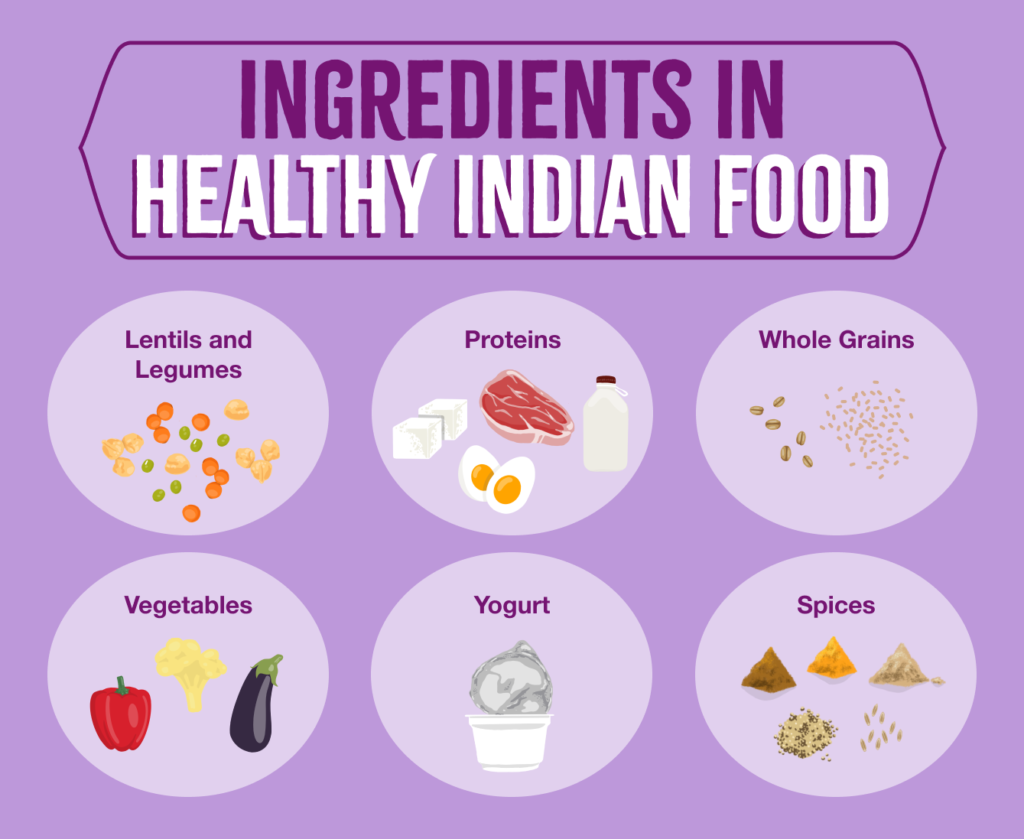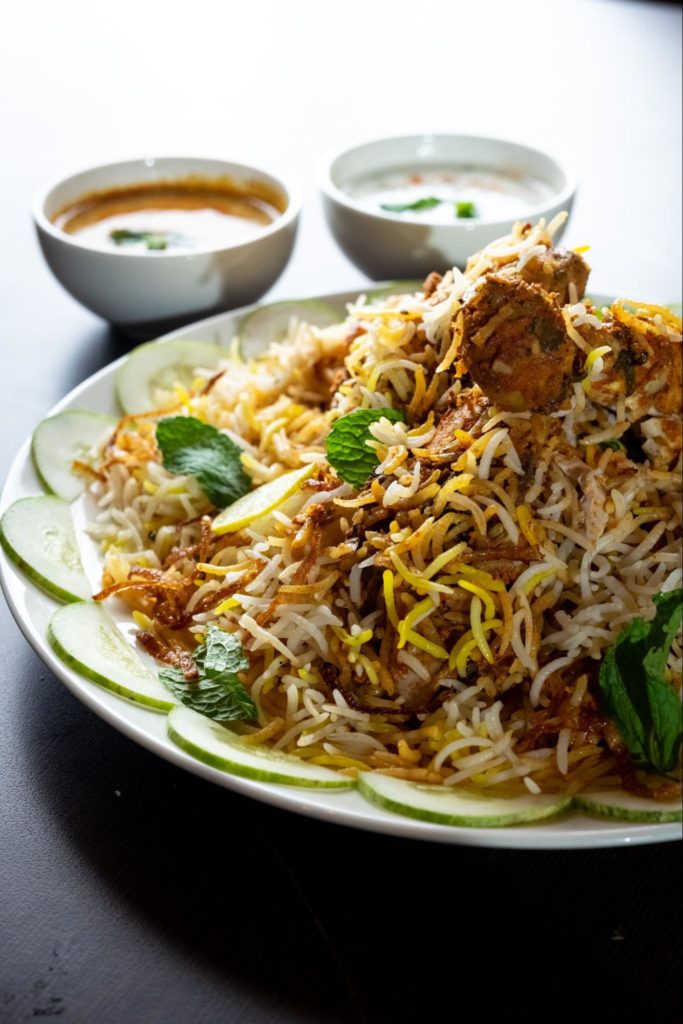Is Indian Food Healthy?
Indian cuisine is known for its rich flavors, aromatic spices, and vibrant colors. Different dishes offer unique tastes and diversity. But, as you dig into your next Tikka Masala, you may wonder: is Indian food healthy?
People often get exposed to Indian food at restaurants which can tend to be more greasy, indulgent, and rich. But like many other cuisines, the home-cooked dishes are prepared in a more healthy way, using less oils, creams, and so on.
Indian recipes often feature a variety of whole grains, legumes, vegetables, and spices that provide a wealth of nutrients to the body. Fresh herbs and spices, such as turmeric, ginger, and cinnamon, are also commonly used, adding flavor and nutrition.
In this article, we’ll delve into the nutritional benefits of Indian cuisine from some of the healthiest Indian foods and recipes.
Ayurveda in Indian Culture
Much of Indian culture focuses on wellness through the body. Ayurvedic principles do just that.
Ayurveda, an ancient system of medicine that originated in India, emphasizes the importance of a balanced diet and lifestyle to promote overall health and well-being. This traditional practice recognizes the unique quality of each individual and recommends specific foods and herbs to promote the body’s balance and harmony.
Ayurvedic principles emphasize the importance of mindful eating and paying attention to the qualities of food, such as taste, texture, and temperature, to support digestion and overall health.

Ingredients that Make Indian Food Healthy
Ingredients play a crucial role in making Indian food healthy and nutritious. Traditional cuisine is known for its diverse components packed with essential nutrients, vitamins, and minerals.
Let’s explore some of the most nutritional choices out there and how they play into your favorite Indian dishes.
Lentils and Legumes
Lentils and legumes, such as chickpeas, black lentils, and mung beans, are staple ingredients in many Indian recipes, like dal (lentil stew) and chana masala.
They are excellent sources of plant-based protein, fiber, vitamins, and minerals, making them a healthy addition to any meal. These ingredients can also reduce the potential risk of chronic diseases like heart disease, diabetes, and even cancer. However, you should always ask your doctor or a health professional before making significant changes in your diet.
Spices
Spices are a crucial part of Indian cuisine, adding not only flavor but also nutritional benefits. Here are some common spices used in Indian cooking and their potential benefits:
- Ginger: Ginger is known for its anti-inflammatory properties and has been shown to help with nausea/upset stomach, reduce anxiety, build immunity, and decrease cholesterol.
- Turmeric: Turmeric, whether fresh root or in a dry powder form, contains anti-inflammatory and antioxidant properties that can help with muscle pain, heart health, and some types of cancer.
- Cumin: Cumin seeds also have antioxidant properties which can possibly help prevent some types of heart disease and high blood pressure.
- Hing (Asafetida): Hing is believed to aid digestion, reduce bloating, and have anti-inflammatory properties.
These are just a few examples. By incorporating a variety of these spices into your meals, you not only add a burst of flavor but also have the potential to reap additional nutrients and health benefits. Please conduct your own research and consult a doctor before incorporating any new spices or herbs into your diet.
Protein
Indian cuisine offers a variety of protein-rich options that can be incorporated into your diet. Protein is an essential nutrient that plays a crucial role in building and repairing healthy tissue in the body. Eating the right amount of protein can help support your immune system by promoting cell growth and regeneration. Proper consumption can also lead to a feeling of fullness, which aids weight management.
Some of the most commonly used sources of protein in Indian cuisine include:
- Meat and poultry: Chicken, lamb, goat, and fish. They are usually cooked with various spices and enjoyed in dishes such as butter chicken, tandoori chicken, and fish curry.
- Eggs: Often used in masala omelet, egg bhurji (scramble), and egg curry.
- Dairy products: Milk, yogurt, and cheese are commonly used in Indian cooking. Paneer, a type of Indian cheese, is particularly popular for vegetarian dishes.
- Nuts and seeds: Almonds, cashews, peanuts, and sesame seeds are commonly used in curries, chutneys, or desserts.
These nutrient-dense proteins won’t just make your meals more flavorful but healthy too.
Whole Grains
Whole grains are a vital part of Indian cuisine, with a rich history dating back thousands of years. They are also an essential component of a healthy and balanced diet, and Indian cuisine is rich in a variety of them. Unlike refined grains, whole grains include the entire grain kernel, which makes them more nutritious.
Some commonly used whole grains in Indian cuisine include whole wheat, millet, sorghum, and rice. They may typically appear in roti, dosa, idli, or biryani. These options are packed with fiber, B vitamins, and minerals and can help sustain energy and support digestion. Experiment with different whole grains to add variety to your meals and reap the benefits.
Vegetables
Most Indian dishes include a variety of vegetables, like spinach, cauliflower, eggplant, and bell peppers. Many of these weren’t originally grown in India but were introduced to India by Portuguese or British colonists. However, they have become an integral part of Indian cuisine and fill many dishes. In fact, many Indians practice a strictly vegetarian diet and it is very easy to do so with the variety of vegetarian curries and dishes in Indian cuisine.
With the colorful and flavorful array of vegetables, you can easily incorporate them into a wholesome meal. Vegetables help boost immunity throughout the body, support gut health, and reduce disease risk. Veggies also provide fiber and key vitamins– another key facet to overall health.
Yogurt
Yogurt has been a staple in Indian cuisine for centuries and has been used as a cooling agent to balance the heat of spices. In fact, it’s one of the oldest fermented foods in the world, with evidence of its consumption dating back to ancient Indian texts.
In Indian cuisine, yogurt (also known as “curd”) is commonly used as a base for chaat dishes, sauces, marinades, as well as a side dish to accompany spicy meals. Raita, a yogurt-based side dish, is a popular accompaniment to biryanis and other rice dishes. In addition to its cooling properties, yogurt also adds a tangy flavor and creamy texture to the dishes, making it a versatile ingredient.

Indian Food Healthy Tips
Now that you know about the healthiest Indian food choices, let’s explore the best ways to cook delicious and nutritious Indian recipes.
Cooking Methods
The way Indian food is prepared plays a role in its healthiness. Deep frying, often associated with greasy Indian food, is not representative of all Indian cuisine.
Much of Indian cuisine often involves cooking methods such as simmering, sauteing, and slow cooking, which can help retain nutrients.
Portion Sizes
Another critical aspect to consider is portion sizes.
In many Indian households, meals are traditionally served family-style, with multiple dishes placed in the center of the table for everyone to share. This approach can be beneficial for portion control, as it encourages individuals to take smaller servings of each dish and avoid overeating.
For maximum benefit, you should still be mindful of your portion sizes, as some dishes can be calorie-dense, thanks to butter and ghee. Opting for smaller portions and being mindful of overall calorie intake will help keep you healthy.
Plant-Based Options
If you’re looking for plant-based Indian meals, you won’t be disappointed. A large portion of Indians are vegetarian, meaning there’s no shortage of options.
Indian cooking offers vegetarian and vegan options, which can be an excellent choice for those following a plant-based diet. The most popular plant-based Indian dishes tend to include:
- Lentils
- Legumes
- Vegetables
- Whole Grains
For more information, follow our Ultimate Guide to Vegetarian Indian Food. You’ll learn about all the best plant-based products, like our scrumptious veggie samosas.
Our Favorite Healthy Indian Recipes
We’ve compiled a few of our favorite healthy Indian recipes, each including various nutritious ingredients. Next time you’re in the kitchen, consider cooking one of these popular recipes.
- Dal Tadka (Indian Lentil Soup)
- Roasted Pumpkin Coconut Curry
- Grilled Double Yogurt Tandoori Chicken
- Rajma Masala
- Vegan Tikka Masala
Load Your Dinner Table With Sukhi’s Delights
At Sukhi’s, we pride ourselves on making Indian food healthy and delicious.
With each of our meals, we aim to take you on a tour of India’s different regions, from the flavorful spices of the North to the aromatic herbs of the South. We carefully craft our dishes using high-quality, fresh ingredients, including lentils, legumes, whole grains, vegetables, and other protein sources, creating flavorful, wholesome meals.
If you don’t want to make your meals, explore our pre-cooked entrees. You may think frozen food is less nutritious, but you’d be wrong. Our myth-busting article will break all your preconceived notions. Our entrees are made with the same attention and care as our fresh meals.
So why wait? Bring the taste of India to your dinner table. You’ll be able to indulge in rich flavors while fueling your body with healthy ingredients. It’s the best of both worlds.
3 responses to Is Indian Food Healthy?
So glad you have made prepared food available at grocery store. I am from Eastern European decent. Indian food is my absolute favorite . Live that I can bring some home to my table.
Your article is very detailed and informative about Indian food
You covered every single point about Indian food. thanks, buddy for giving that much information about Indian food.